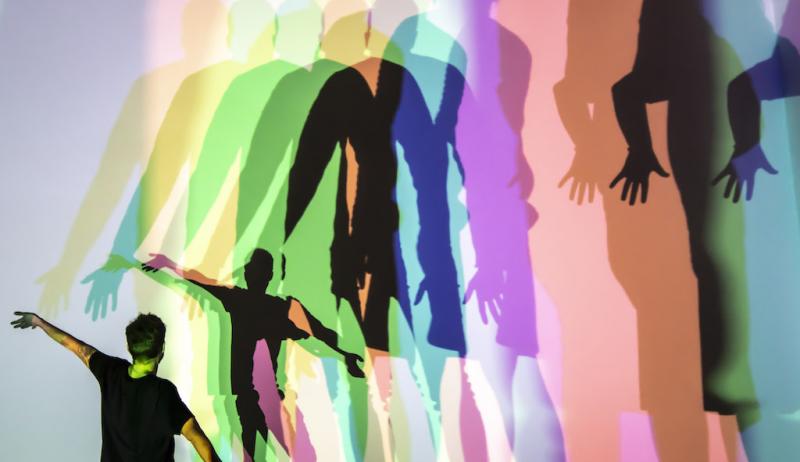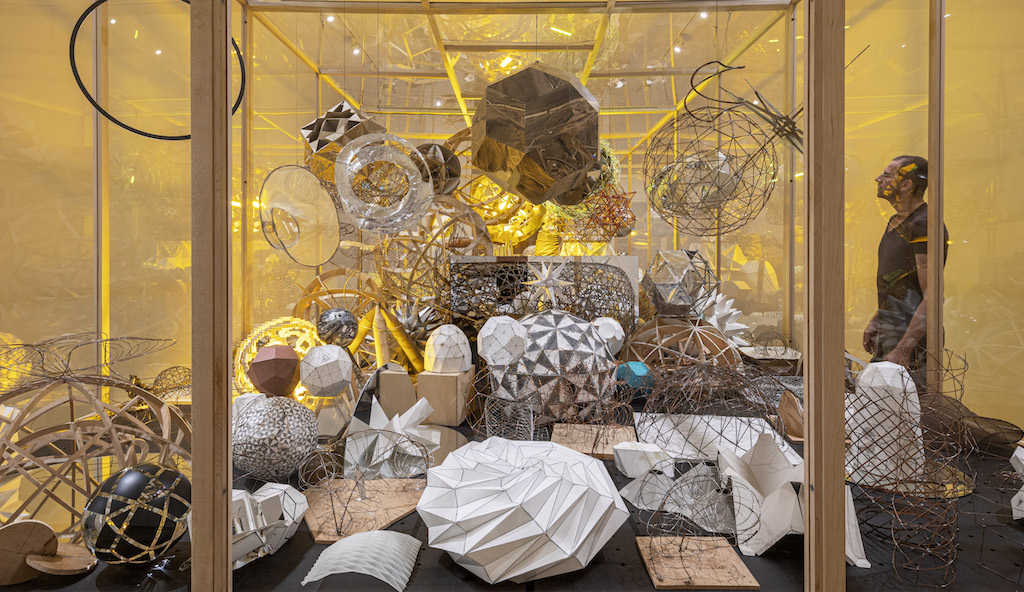Olafur Eliasson: In Real Life, Tate Modern review – beautiful ideas badly installed | reviews, news & interviews
Olafur Eliasson: In Real Life, Tate Modern review – beautiful ideas badly installed
Olafur Eliasson: In Real Life, Tate Modern review – beautiful ideas badly installed
The Danish artist who opens our eyes to climate change

At their best, Olafur Eliasson’s installations change the way you see, think and feel. Who would have guessed, for instance, that Londoners would take off their togs to bask in the glow of an artificial sun at Tate Modern. That was in 2003, when The weather project transformed the Turbine Hall into an indoor park suffused with yellow light.
Then last winter, Eliasson brought us Ice Watch. Fished from a fjord in Greenland, blocks of 10,000 year old ice were left to melt on Tate Modern’s lawn. Not only were the effects of global warming made horrifyingly apparent, but the euphoria induced by The weather project was turned on its head – to become a warning.
 Now Tate Modern is staging a survey of the Danish artists’s work. In Real Life is interesting and informative, but the wow factor that changes people’s perceptions is largely absent. A bronze cast of a melted ice lump may be good for selfies, but is too cerebral to press home its message.
Now Tate Modern is staging a survey of the Danish artists’s work. In Real Life is interesting and informative, but the wow factor that changes people’s perceptions is largely absent. A bronze cast of a melted ice lump may be good for selfies, but is too cerebral to press home its message.
The fault is often poor installation. At the National Gallery last year, Room for one colour was realised as an enclosed space filled with intense yellow light. It stopped you in your tracks; everything looked flat, sickly and unreal. Normal perception was revealed to be relative, provisional – a mere trick of the light. At Tate Modern the piece is reduced to rows of neon tubes hung outside the lifts; they are scarcely noticeable, let alone transformative.
In one room, water trickles down a window. Rain Window is a lovely idea, but I wonder how many people will spot it ? One of the most affecting works is also the simplest. I grew up in solitude and silence, 1991 consists of a lit candle standing on a circular mirror; but to convey its poetic and somewhat melancholy message, it needs space – and solitude.
Your Blind Passenger, 2010 (pictured above right) is the only truly immersive work. Filled with yellow mist, the 39 metre corridor is long enough to be genuinely disorientating. Don’t get me wrong; I’m not a wow-factor junkie. On the contrary, I respond to art that works slowly, but too many of the pieces here are little more than fun. The rainbow shadows cast by spotlights in Your Uncertain Shadow, for instance, (main picture) are beautiful but transitory, in every sense of the word. Eliasson uses art to open our eyes to the disastrous impact we are having on the planet. I applaud the ambition, but this exhibition doesn’t do it justice. In his Berlin studio, he works with architects, art historians, designers, technicians, film-makers and chefs on projects like Little Sun, solar powered torches developed for use in countries without electricity (pictured above: models for prejects developed with architect Einar Thorsteinn). The final room provides a glimpse into activities like these, which take his practice way beyond the narrow remit of art. That, the vegetarian restaurant downstairs serving Olafur Eliasson food and the accompanying discussions and workshops are the most inspiring aspects of this rather disappointing survey.
Eliasson uses art to open our eyes to the disastrous impact we are having on the planet. I applaud the ambition, but this exhibition doesn’t do it justice. In his Berlin studio, he works with architects, art historians, designers, technicians, film-makers and chefs on projects like Little Sun, solar powered torches developed for use in countries without electricity (pictured above: models for prejects developed with architect Einar Thorsteinn). The final room provides a glimpse into activities like these, which take his practice way beyond the narrow remit of art. That, the vegetarian restaurant downstairs serving Olafur Eliasson food and the accompanying discussions and workshops are the most inspiring aspects of this rather disappointing survey.
rating
Explore topics
Share this article
Add comment
The future of Arts Journalism
You can stop theartsdesk.com closing!
We urgently need financing to survive. Our fundraising drive has thus far raised £49,000 but we need to reach £100,000 or we will be forced to close. Please contribute here: https://gofund.me/c3f6033d
And if you can forward this information to anyone who might assist, we’d be grateful.

Subscribe to theartsdesk.com
Thank you for continuing to read our work on theartsdesk.com. For unlimited access to every article in its entirety, including our archive of more than 15,000 pieces, we're asking for £5 per month or £40 per year. We feel it's a very good deal, and hope you do too.
To take a subscription now simply click here.
And if you're looking for that extra gift for a friend or family member, why not treat them to a theartsdesk.com gift subscription?
more Visual arts
 'We are bowled over!' Thank you for your messages of love and support
Much-appreciated words of commendation from readers and the cultural community
'We are bowled over!' Thank you for your messages of love and support
Much-appreciated words of commendation from readers and the cultural community
![SEX MONEY RACE RELIGION [2016] by Gilbert and George. Installation shot of Gilbert & George 21ST CENTURY PICTURES Hayward Gallery](https://theartsdesk.com/sites/default/files/styles/thumbnail/public/mastimages/Gilbert%20%26%20George_%2021ST%20CENTURY%20PICTURES.%20SEX%20MONEY%20RACE%20RELIGION%20%5B2016%5D.%20Photo_%20Mark%20Blower.%20Courtesy%20of%20the%20Gilbert%20%26%20George%20and%20the%20Hayward%20Gallery._0.jpg?itok=7tVsLyR-) Gilbert & George, 21st Century Pictures, Hayward Gallery review - brash, bright and not so beautiful
The couple's coloured photomontages shout louder than ever, causing sensory overload
Gilbert & George, 21st Century Pictures, Hayward Gallery review - brash, bright and not so beautiful
The couple's coloured photomontages shout louder than ever, causing sensory overload
 Lee Miller, Tate Britain review - an extraordinary career that remains an enigma
Fashion photographer, artist or war reporter; will the real Lee Miller please step forward?
Lee Miller, Tate Britain review - an extraordinary career that remains an enigma
Fashion photographer, artist or war reporter; will the real Lee Miller please step forward?
 Kerry James Marshall: The Histories, Royal Academy review - a triumphant celebration of blackness
Room after room of glorious paintings
Kerry James Marshall: The Histories, Royal Academy review - a triumphant celebration of blackness
Room after room of glorious paintings
 Folkestone Triennial 2025 - landscape, seascape, art lovers' escape
Locally rooted festival brings home many but not all global concerns
Folkestone Triennial 2025 - landscape, seascape, art lovers' escape
Locally rooted festival brings home many but not all global concerns
 Sir Brian Clarke (1953-2025) - a personal tribute
Remembering an artist with a gift for the transcendent
Sir Brian Clarke (1953-2025) - a personal tribute
Remembering an artist with a gift for the transcendent
 Emily Kam Kngwarray, Tate Modern review - glimpses of another world
Pictures that are an affirmation of belonging
Emily Kam Kngwarray, Tate Modern review - glimpses of another world
Pictures that are an affirmation of belonging
 Kiefer / Van Gogh, Royal Academy review - a pairing of opposites
Small scale intensity meets large scale melodrama
Kiefer / Van Gogh, Royal Academy review - a pairing of opposites
Small scale intensity meets large scale melodrama
 Jenny Saville: The Anatomy of Painting, National Portrait Gallery review - a protégé losing her way
A brilliant painter in search of a worthwhile subject
Jenny Saville: The Anatomy of Painting, National Portrait Gallery review - a protégé losing her way
A brilliant painter in search of a worthwhile subject
 Abstract Erotic, Courtauld Gallery review - sculpture that is sensuous, funny and subversive
Testing the boundaries of good taste, and winning
Abstract Erotic, Courtauld Gallery review - sculpture that is sensuous, funny and subversive
Testing the boundaries of good taste, and winning
 Edward Burra, Tate Britain review - watercolour made mainstream
Social satire with a nasty bite
Edward Burra, Tate Britain review - watercolour made mainstream
Social satire with a nasty bite
 Ithell Colquhoun, Tate Britain review - revelations of a weird and wonderful world
Emanations from the unconscious
Ithell Colquhoun, Tate Britain review - revelations of a weird and wonderful world
Emanations from the unconscious

Comments
This is a really